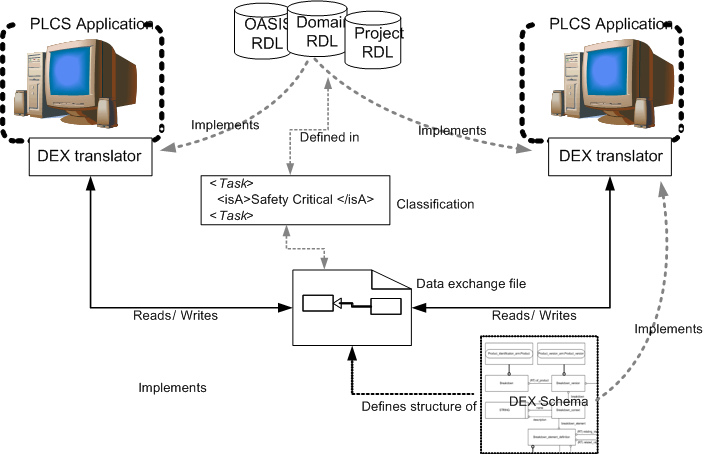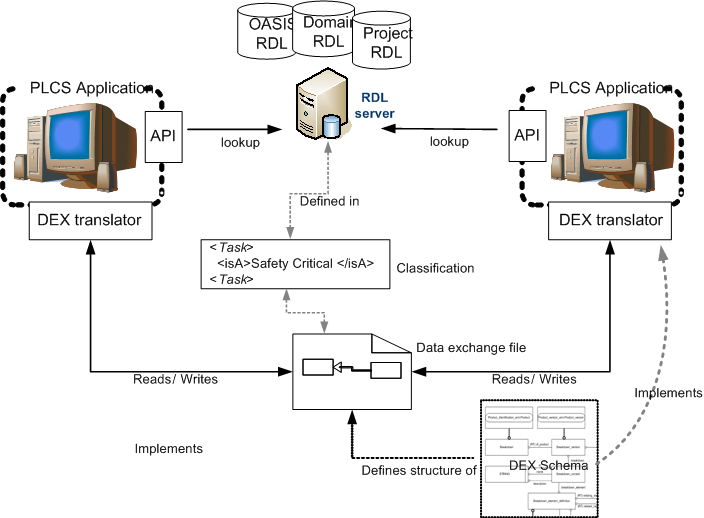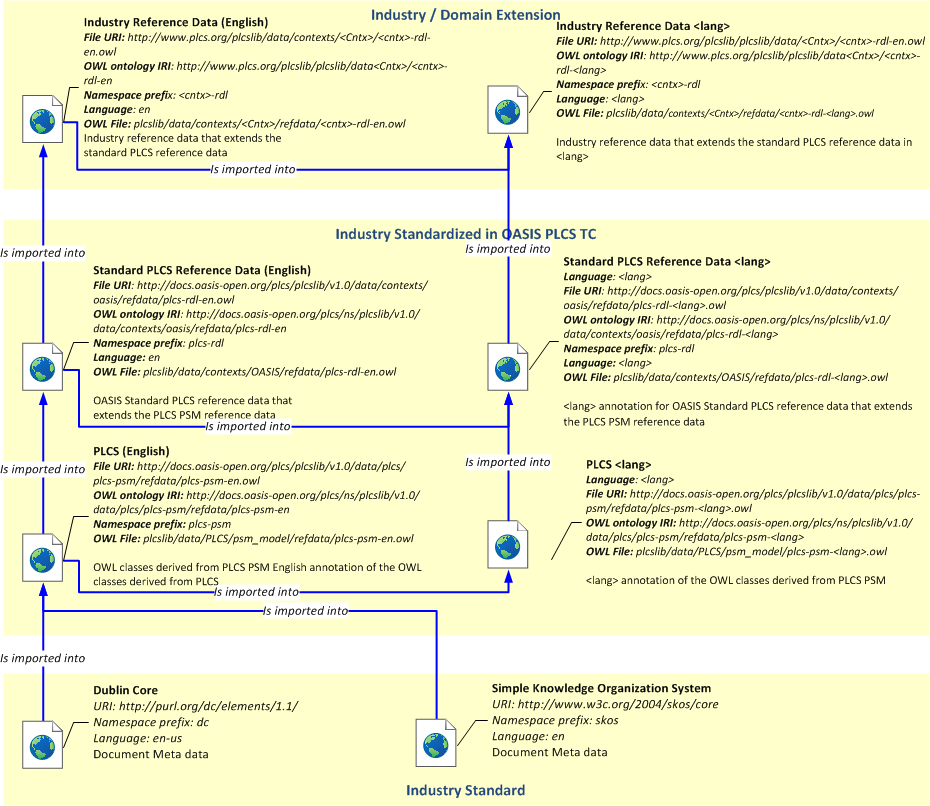In order for the ISO 10303-239 PLCS information model to be usable in many different Contexts, it is deliberately generic. In other words, PLCS PSM SysML blocks are provided for representing constructs such as parts and dates and their relationships. More specialized semantic definitions of constructs such as a "safety critical part", or a "creation date" are not represented directly in the ISO 10303-239 PLCS standard. Instead provision is made to enable the same semantic precision by adding a classification scheme to the basic constructs using Reference Data, thus refining or augmenting the meaning of the entity.
For example, there are many different types of properties associated with components that are relevant to product life cycle support. The information model defines the basic representation of a property on a part and enables the properties to be classified. The classification mechanism is then used to define the specific type of property. The reason for using classification in this way is that any set of specific property types, such as "mean time to failure" that could have been provided by explicit modelling in the standard is likely to be incomplete. Furthermore, as business practices change, different properties are likely to be required over time and these can be introduced by means of a new class, without having to re-issue the standard.
Classification of PLCS PSM SysML blocks allows for the semantic refinement of the ISO 10303-239 PLCS information model. It is vital to ensure that all partners in a data exchange have a shared understanding of what each classification means. The classifiers used are referred as "Reference Data" and are held in a shared class libraries referred to as "Reference Data Librarys" (RDLs). These are available to all parties in a data exchange and hold definitions and sources for the classifiers or reference data items.
A Reference Data concept (e.g. term, definition and rules) in the RDL is called a "Reference Data Class", or sometimes "RDL class".
Definition: Reference DataReference Data is data that represents information about classes or individuals which are common to many users.
A Reference Data Library (RDL) is a managed collection of Classes and Individuals that are specified separate to and referenced from a data exchange file.
When deploying PLCS data exchanges the Reference data can be encoded into the system translators as illustrated in Figure 3. Whilst this approach leads to an efficient implementation, it is inflexible. Whenever new Reference Data is created it will require that the translators are modified
An alternative approach to deploying PLCS data exchanges is to make the Reference Data Libraries available in a server, referred to as an "RDL server". Such a server would be dynamically accessed at run time by all translators involved in any exchange. The Reference Data Classes referenced in any data exchange file could then be looked up in the server, and sub class / super class or language specific term type queries could be performed. An example of how external Reference Data Libraries, using an RDL server, allow for the automatic look-up of classes in an implementation is shown if Figure 2 Multiple RDLs are required to cover the different levels of specialization, e.g. business domain, project, organization. The specialized Reference Data for each level is stored in a separate RDL, which in turn inherits Reference Data from more general RDLs (such as the OASIS PLCS RDL).
The standardized PLCS Reference Data is made up of several related Reference Data Libraries:
- a representation of a classifiable subset of the PLCS PSM schema as an OWL ontology;
- the Reference Data itself, which includes:
- Classes,
- a Class hierarchy,
- properties of the Classes,
- instances or Individuals based on the Classes,
- relationships between Classes, and
- relationships between Class hierarchies and relevant PLCS PSM schema elements.
- a set of annotations based on a subset of the Dublin Core meta-data elements and Simple Knowledge Organization System for clear specification of the concepts and internal management of the Reference Data.
The diagram in Figure 3 illustrates the architecture of the different Reference Data Libraries.
There are two main types of Reference Data applicable to PLCS DEX usage scenarios:
- PLCS standard Reference Data published through the OASIS PLCS Technical Committee. This is the Reference Data that all PLCS implementations must be able to support and that is the basis for:
- Extensions to the standard Reference Data. These may be shared, and perhaps standardized, across an industry sector, or may be project-, contract-, country-, or company-specific.
Each organization or project may extend the standardized Reference Data. Extensions are defined by importing the complete Reference Data Library and adding organization- or project-specific subclasses of the standardized Reference Data Libraries. Extensions are intended to be managed in separate datasets and only merged back into the standardized PLCS Reference Data as a result of a harmonization, integration, and revision activities.
Extensions may also be used to add language specific translations to classes and individuals allowing them to be understood more easily in environments where English is not the standard language.
The standardized PLCS Reference Data is created and published using the W3C Web Ontology Language (OWL). Each RDL containing the standardized Reference Data becomes an OWL ontology in its own right. Each OWL ontology imports other ontologies (RDLs) as required, grouping them together in order to make extension simple and in order to present a single ontology to the end user.. It is intended that organization- or project-specific extensions to the standardized Reference Data are created with their own OWL ontologies.
While OWL may have any of several formats, the OWL RDF/XML (unabbreviated) syntax is used for the PLCS Reference Data. This allows the use of XML-related languages and tools for the creation and management of the Reference Data.
OWL is by-design a Web-enabled technology and so publication of the
standardized urn:plcs:rdl:std Reference Data make the OWL files available to Web users.
OASIS has specified that HTTP URIs (i.e. URLs) are to be used for their standards
and so references to the Reference Data are made using those URIs at:
http://docs.oasis-open.org where a 'plcs' folder holds the OWL files.






